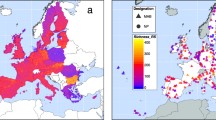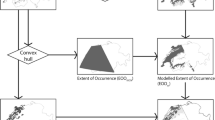Abstract
Local autocorrelation statistics offer new opportunities for the discrimination of important conservation areas since the spatial dependence of local values upon neighbouring ones may assist conservation decisions. We exemplify the use of local autocorrelation statistics for conservation purposes using data on Spanish threatened invertebrates to identify areas composed of similarly species-rich localities (hot spots), species-rich “islands”, cold spots and species-poor “islands”. In order to assess the probable causes of the detected patterns differences in environmental, land use and protected area variables were examined between the different regions. Distributional data for threatened invertebrate species in Spain at 100 km2 UTM cell resolution were used. After defining a neighbouring area, statistically significant local autocorrelation values (both positive and negative) were estimated. Kruskal–Wallis ANOVA by rank test was used to compare the environmental, land use and protected area percentages between the cells of the different regions. Around 11 and 2 % of total cells can be considered hot spots and rich “islands”, respectively. Hot spots are characterized by a lower percentage of anthropic land uses and a higher percentage of current protected area. However, approximately a third part of these cells possess at least 98 % of their area unprotected. Rich “island” cells are not environmentally different from those considered as cold spots, though experiencing a lower rate of anthropization and higher proportion of protected area. Unfortunately, almost 70 % of these rich “island” cells have <2 % of their areas currently protected. The use of local autocorrelation statistics on species richness values may complement conservation decisions by discriminating interconnected sites facilitating local persistence (hot spots) as well as isolated and vulnerable sites (rich “islands”). The study of different variables associated with these regions allows us to suggest determinant causal factors. Our results suggest that land use changes due to human activities are the main cause of threats.

Similar content being viewed by others
References
Anselin L (1995) Local indicators of spatial association—LISA. Geogr Anal 27:93–115
Araújo MB, Lobo JM, Moreno JC (2007) The effectiveness of iberian protected areas in conserving terrestrial biodiversity. Conserv Biol 21:1423–1432
Bini LM, Diniz Filho JAF, Bonfim F, Bastos RP, Ross ST (2000) Local and regional species richness relationships in viperid snake assemblages from South America: unsaturated patterns at three different spatial scales. Copeia 2000:799–805
Branquart E, Verheyen K, Latham J (2008) Selection criteria of protected forest areas in Europe: the theory and the real world. Biol Conserv 141:2795–2806
Briers RA (2002) Incorporating connectivity into reserve selection procedures. Biol Conserv 103:77–83
Cabeza M, Moilanen A (2001) Design of reserve networks and the persistence of biodiversity. Trends Ecol Evol 16:242–248
Cabeza M, Moilanen A (2003) Site-selection algorithms and habitat loss. Conserv Biol 17:1402–1413
Carrión JS, Fernández S, González-Sampériz P, Gil-Romera G, Badal E, Carrión-Marco Y, López-Merino L, López-Sáez JA, Fierro E, Burjachs F (2010) Expected trends and surprises in the Lateglacial and Holocene vegetation history of the Iberian Peninsula and Balearic Islands. Rev Palaeobot Palyno 162:458–475
Carroll C, Noss RF, Paquet PC, Schumaker NH (2003) Use of population viability analysis and reserve selection algorithms in regional conservation plans. Ecol Appl 13:1773–1789
Clark-Labs (2000) Global change data archive. In: 1 km global elevation model Clark University CD-Rom
Costanza R, Daly HE (1992) Natural capital and sustainable development. Conserv Biol 6:37–46
Dennis P, Aspinall R, Gordon IJ (2002) Spatial distribution of upland beetles in relation to landform, vegetation and grazing management. Basic Appl Ecol 3:183–193
Diniz-Filho JAF, De Campos Telles MP (2002) Spatial autocorrelation analysis and the identification of operational units for conservation in continuous populations. Conserv Biol 16:924–935
Double MC, Peakall R, Beck NR, Cockburn A (2005) Dispersal, philopatry, and infidelity: dissecting local genetic structure in superb fairy-wrens (Malurus cyaneus). Evolution 59:625–635
Europarc-España (2008) Mapa de áreas protegidas de España. Europarc, Madrid
Fox JE, McGrady-Steed J, Petchey OL (2000) Testing for local species saturation with nonindependent regional species pools. Ecol Lett 3:198–206
Franco-Múgica F, García-Antón M, Maldonado-Ruiz J, Morla-Juaristi C, Sainz-Ollero H (2005) Ancient pine forest on inland dunes in the Spanish northern meseta. Quaternary Res 63:1–14
Hernández-Manrique OL, Numa C, Verdú JR, Galante E, Lobo JM (2012) Current protected sites do not allow the representation of endangered invertebrates: the Spanish case. Insect Conserv Div. doi:10.1111/j.1752-4598.2011.00175.x
Hijmans RJ, Cameron S, Parra JL, Jones P, Jarvis A (2005) Very high resolution interpolated climate surfaces for global land areas. International J Climatol 25:1965–1978
Justus J, Sarkar S (2002) The principle of complementarity in the design of reserve networks to conserve biodiversity: a preliminary history. J Bioscience 27:421–435
Knight AT, Cowling RM, Rouget M, Balmford A, Lombard AT, Campbell BM (2008) Knowing but not doing: selecting priority conservation areas and the research–implementation gap. Conserv Biol 22:610–617
Koenig WD (2001) Spatial autocorrelation and local disappearances in wintering North American birds. Ecology 82:2636–2644
Laguna E, Deltoro VI, Pèrez-Botella J, Pèrez-Rovira P, Serra L, Olivares A, Fabregat C (2004) The role of small reserves in plant conservation in a region of high diversity in eastern Spain. Biol Conserv 119:421–426
Leather SR, Basset Y, Hawkins BA (2008) Insect conservation: finding the way forward. Insect Conserv Diver 1:67–69
Leduc A, Drapeau P, Bergeron Y, Legendre P (1992) Study of spatial components of forest cover using partial mantel tests and path analysis. J Veg Sci 3:69–78
Legendre P (1993) Spatial autocorrelation: trouble or new paradigm? Ecology 74:1659–1673
Legendre P, Fortin MJ (1989) Spatial pattern and ecological analysis. Plant Ecol 68:107–138
Lenzen M, Lane A, Widmer-Cooper A, Williams M (2009) Effects of land use on threatened species. Conserv Biol 23:294–306
Margules CR, Pressey RL (2000) Systematic conservation planning. Nature 405:243–253
Margules CR, Nicholls AO, Pressey RL (1988) Selecting networks of reserves to maximise biological diversity. Biol Conserv 43:63–76
Martín-Piera F (2001) Area networks for conserving iberian insects: a case study of dung beetles (col., Scarabaeoidea). J Insect Conserv 5:233–252
Nelson TA, Boots B (2008) Detecting spatial hot spots in landscape ecology. Ecography 31:556–566
Nicholls AO, Margules CR (1993) An upgraded reserve selection algorithm. Biol Conserv 64:165–169
Niggebrugge K, Durance I, Watson AM, Leuven RSEW, Ormerod SJ (2007) Applying landscape ecology to conservation biology: spatially explicit analysis reveals dispersal limits on threatened wetland gastropods. Biol Conserv 139:286–296
Pressey RL (1994) Ad hoc reservations: forward or backward steps in developing representative reserve systems? Conserv Biol 8:662–668
Pressey RL, Humphries CJ, Margules CR, Vane-Wright RI, Williams PH (1993) Beyond opportunism: key principles for systematic reserve selection. Trends Ecol Evol 8:124–128
Pullin AS, Báldi A, Can OE, Dieterich M, Kati V, Livoreil B, Löei G, Mihók B, Nevin O, Selva N, Sousa-Pinto I (2009) Conservation focus on Europe: major conservation policy issues that need to be informed by conservation science. Conserv Biol 23:818–824
Rahbek C, Graves GR (2001) Multiscale assessment of patterns of avian species richness. Proc Natl Acad Sci 98:4534–4539
Ramos MA, Lobo JM, Esteban M (2001) Ten years inventorying the Iberian fauna: results and perspectives. Biodivers Conserv 10:19–28
Rangel TF, Diniz-Filho JAF, Bini LM (2010) SAM: a comprehensive application for spatial analysis in macroecology. Ecography 33:46–50
Rey-Benayas JM, Scheiner SM (2002) Plant diversity, biogeography and environment in Iberia: patterns and possible causal factors. J Veg Sci 13:245–258
Romo H, Munguira ML, García-Barros E (2007) Area selection for the conservation of butterflies in the Iberian Peninsula and Balearic Islands. Anim Biodivers Conserv 30:7–27
Sánchez-Fernández D, Bilton DT, Abellán P, Ribera I, Velasco J, Millán A (2008) Are the endemic water beetles of the Iberian Peninsula and the Balearic Islands effectively protected? Biol Conserv 141:1612–1627
Sarkar S, Pressey RL, Faith DP, Margules CR, Fuller T, Stoms DM, Moffett A, Wilson KA, Williams KJ, Williams PH, Andelman S (2006) Biodiversity conservation planning tools: present status and challenges for the future. Annu Rev Env Resour 31:123–159
Siegel S, Castellan NJ (1988) Nonparametric statistics for the behavioral sciences. McGraw-Hill, New York
Sokal RR, Thomson BA (2006) Population structure inferred by local spatial autocorrelation: an example from an Amerindian tribal population. Am J Phys Anthropol 129:121–131
Sokal RR, Oden NL, Thomson BA (1998) Local spatial autocorrelation in biological variables. Biol J Linn Soc 65:41–62
Underwood EC, Klausmeyer KR, Cox RL, Busby SM, Morrison SA, Shaw MR (2009) Expanding the global network of protected areas to save the imperiled mediterranean biome. Conserv Biol 23:43–52
Vane-Wright RI, Humphries CJ, Williams PH (1991) What to protect? Systematics and the agony of choice. Biol Conserv 55:235–254
Verdú JR, Galante E (2008) Atlas de los invertebrados Amenazados de España (Especies En Peligro Crítico y En Peligro). Dirección General para la Biodiversidad, Ministerio de Medio Ambiente, Medio Rural y Marino, Madrid
Verdú JR, Numa C, Galante E (2011) Atlas y Libro Rojo de los Invertebrados amenazados de España (Especies Vulnerables). Dirección General para la Biodiversidad, Ministerio de Medio Ambiente, Medio Rural y Marino, Madrid
Wiersma YF, Nudds TD (2009) Efficiency and effectiveness in representative reserve design in Canada: the contribution of existing protected areas. Biol Conserv 142:1639–1646
Williams JC, ReVelle CS, Levin SA (2004) Using mathematical optimization models to design nature reserves. Front Ecol Environ 2:98–105
Wilson RJ, Gutiérrez D, Gutiérrez J, Martínez D, Agudo R, Monserrat VJ (2005) Changes to the elevational limits and extent of species ranges associated with climate change. Ecol Lett 8:1138–1146
Zamin TJ, Baillie JE, Miller RM, Rodriguez JP, Ardid A, Collen B (2010) National red listing beyond the 2010 target. Conserv Biol 24:1012–1020
Acknowledgments
We thank all authors who participate in the Atlas of Threatened Invertebrates of Spain. This work was supported by the project Atlas of Threatened Invertebrates of Spain (Ministerio de Medio Ambiente, Medio Rural y Marino) carried out by the Spanish Association of Entomology (AeE) and the Spanish Society of Malacology (SEM).
Author information
Authors and Affiliations
Corresponding author
Electronic supplementary material
Below is the link to the electronic supplementary material.
Rights and permissions
About this article
Cite this article
Hernández-Manrique, O.L., Sánchez-Fernández, D., Verdú, J.R. et al. Using local autocorrelation analysis to identify conservation areas: an example considering threatened invertebrate species in Spain. Biodivers Conserv 21, 2127–2137 (2012). https://doi.org/10.1007/s10531-012-0303-5
Received:
Accepted:
Published:
Issue Date:
DOI: https://doi.org/10.1007/s10531-012-0303-5




